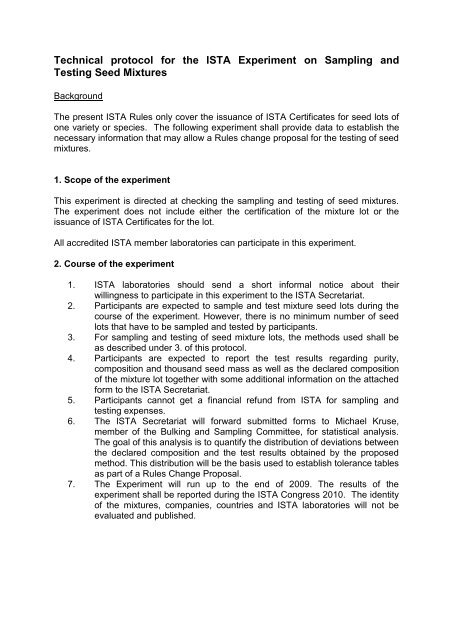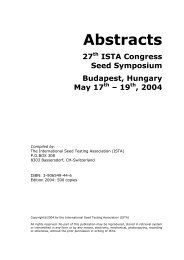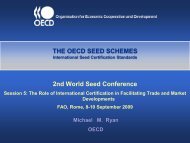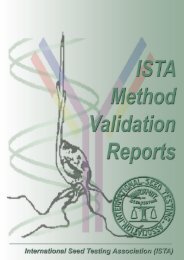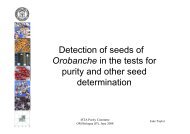Technical protocol for the ISTA Experiment on Sampling and Testing ...
Technical protocol for the ISTA Experiment on Sampling and Testing ...
Technical protocol for the ISTA Experiment on Sampling and Testing ...
Create successful ePaper yourself
Turn your PDF publications into a flip-book with our unique Google optimized e-Paper software.
<str<strong>on</strong>g>Technical</str<strong>on</strong>g> <str<strong>on</strong>g>protocol</str<strong>on</strong>g> <str<strong>on</strong>g>for</str<strong>on</strong>g> <str<strong>on</strong>g>the</str<strong>on</strong>g> <str<strong>on</strong>g>ISTA</str<strong>on</strong>g> <str<strong>on</strong>g>Experiment</str<strong>on</strong>g> <strong>on</strong> <strong>Sampling</strong> <strong>and</strong><br />
<strong>Testing</strong> Seed Mixtures<br />
Background<br />
The present <str<strong>on</strong>g>ISTA</str<strong>on</strong>g> Rules <strong>on</strong>ly cover <str<strong>on</strong>g>the</str<strong>on</strong>g> issuance of <str<strong>on</strong>g>ISTA</str<strong>on</strong>g> Certificates <str<strong>on</strong>g>for</str<strong>on</strong>g> seed lots of<br />
<strong>on</strong>e variety or species. The following experiment shall provide data to establish <str<strong>on</strong>g>the</str<strong>on</strong>g><br />
necessary in<str<strong>on</strong>g>for</str<strong>on</strong>g>mati<strong>on</strong> that may allow a Rules change proposal <str<strong>on</strong>g>for</str<strong>on</strong>g> <str<strong>on</strong>g>the</str<strong>on</strong>g> testing of seed<br />
mixtures.<br />
1. Scope of <str<strong>on</strong>g>the</str<strong>on</strong>g> experiment<br />
This experiment is directed at checking <str<strong>on</strong>g>the</str<strong>on</strong>g> sampling <strong>and</strong> testing of seed mixtures.<br />
The experiment does not include ei<str<strong>on</strong>g>the</str<strong>on</strong>g>r <str<strong>on</strong>g>the</str<strong>on</strong>g> certificati<strong>on</strong> of <str<strong>on</strong>g>the</str<strong>on</strong>g> mixture lot or <str<strong>on</strong>g>the</str<strong>on</strong>g><br />
issuance of <str<strong>on</strong>g>ISTA</str<strong>on</strong>g> Certificates <str<strong>on</strong>g>for</str<strong>on</strong>g> <str<strong>on</strong>g>the</str<strong>on</strong>g> lot.<br />
All accredited <str<strong>on</strong>g>ISTA</str<strong>on</strong>g> member laboratories can participate in this experiment.<br />
2. Course of <str<strong>on</strong>g>the</str<strong>on</strong>g> experiment<br />
1. <str<strong>on</strong>g>ISTA</str<strong>on</strong>g> laboratories should send a short in<str<strong>on</strong>g>for</str<strong>on</strong>g>mal notice about <str<strong>on</strong>g>the</str<strong>on</strong>g>ir<br />
willingness to participate in this experiment to <str<strong>on</strong>g>the</str<strong>on</strong>g> <str<strong>on</strong>g>ISTA</str<strong>on</strong>g> Secretariat.<br />
2. Participants are expected to sample <strong>and</strong> test mixture seed lots during <str<strong>on</strong>g>the</str<strong>on</strong>g><br />
course of <str<strong>on</strong>g>the</str<strong>on</strong>g> experiment. However, <str<strong>on</strong>g>the</str<strong>on</strong>g>re is no minimum number of seed<br />
lots that have to be sampled <strong>and</strong> tested by participants.<br />
3. For sampling <strong>and</strong> testing of seed mixture lots, <str<strong>on</strong>g>the</str<strong>on</strong>g> methods used shall be<br />
as described under 3. of this <str<strong>on</strong>g>protocol</str<strong>on</strong>g>.<br />
4. Participants are expected to report <str<strong>on</strong>g>the</str<strong>on</strong>g> test results regarding purity,<br />
compositi<strong>on</strong> <strong>and</strong> thous<strong>and</strong> seed mass as well as <str<strong>on</strong>g>the</str<strong>on</strong>g> declared compositi<strong>on</strong><br />
of <str<strong>on</strong>g>the</str<strong>on</strong>g> mixture lot toge<str<strong>on</strong>g>the</str<strong>on</strong>g>r with some additi<strong>on</strong>al in<str<strong>on</strong>g>for</str<strong>on</strong>g>mati<strong>on</strong> <strong>on</strong> <str<strong>on</strong>g>the</str<strong>on</strong>g> attached<br />
<str<strong>on</strong>g>for</str<strong>on</strong>g>m to <str<strong>on</strong>g>the</str<strong>on</strong>g> <str<strong>on</strong>g>ISTA</str<strong>on</strong>g> Secretariat.<br />
5. Participants cannot get a financial refund from <str<strong>on</strong>g>ISTA</str<strong>on</strong>g> <str<strong>on</strong>g>for</str<strong>on</strong>g> sampling <strong>and</strong><br />
testing expenses.<br />
6. The <str<strong>on</strong>g>ISTA</str<strong>on</strong>g> Secretariat will <str<strong>on</strong>g>for</str<strong>on</strong>g>ward submitted <str<strong>on</strong>g>for</str<strong>on</strong>g>ms to Michael Kruse,<br />
member of <str<strong>on</strong>g>the</str<strong>on</strong>g> Bulking <strong>and</strong> <strong>Sampling</strong> Committee, <str<strong>on</strong>g>for</str<strong>on</strong>g> statistical analysis.<br />
The goal of this analysis is to quantify <str<strong>on</strong>g>the</str<strong>on</strong>g> distributi<strong>on</strong> of deviati<strong>on</strong>s between<br />
<str<strong>on</strong>g>the</str<strong>on</strong>g> declared compositi<strong>on</strong> <strong>and</strong> <str<strong>on</strong>g>the</str<strong>on</strong>g> test results obtained by <str<strong>on</strong>g>the</str<strong>on</strong>g> proposed<br />
method. This distributi<strong>on</strong> will be <str<strong>on</strong>g>the</str<strong>on</strong>g> basis used to establish tolerance tables<br />
as part of a Rules Change Proposal.<br />
7. The <str<strong>on</strong>g>Experiment</str<strong>on</strong>g> will run up to <str<strong>on</strong>g>the</str<strong>on</strong>g> end of 2009. The results of <str<strong>on</strong>g>the</str<strong>on</strong>g><br />
experiment shall be reported during <str<strong>on</strong>g>the</str<strong>on</strong>g> <str<strong>on</strong>g>ISTA</str<strong>on</strong>g> C<strong>on</strong>gress 2010. The identity<br />
of <str<strong>on</strong>g>the</str<strong>on</strong>g> mixtures, companies, countries <strong>and</strong> <str<strong>on</strong>g>ISTA</str<strong>on</strong>g> laboratories will not be<br />
evaluated <strong>and</strong> published.
3. Methods <str<strong>on</strong>g>for</str<strong>on</strong>g> sampling <strong>and</strong> testing seed mixtures<br />
<strong>Sampling</strong><br />
The <str<strong>on</strong>g>ISTA</str<strong>on</strong>g> Rules Chapter 2 shall be followed <str<strong>on</strong>g>for</str<strong>on</strong>g> sampling mixture seed lots <strong>and</strong> <str<strong>on</strong>g>for</str<strong>on</strong>g><br />
obtaining working samples <str<strong>on</strong>g>for</str<strong>on</strong>g> testing by taking into account <str<strong>on</strong>g>the</str<strong>on</strong>g> following additi<strong>on</strong>al<br />
regulati<strong>on</strong>s, restricti<strong>on</strong>s <strong>and</strong> changes.<br />
Definiti<strong>on</strong>s<br />
(The <str<strong>on</strong>g>ISTA</str<strong>on</strong>g> Rules 2.2)<br />
2.2. Seed Mixture Lot<br />
A seed mixture lot is a specified quantity of seed that is physically <strong>and</strong> uniquely<br />
identifiable <strong>and</strong> includes by declarati<strong>on</strong> seed of two or more species.<br />
2.2 Mixture Comp<strong>on</strong>ents<br />
A mixture comp<strong>on</strong>ent is seed of a species or variety that is given in <str<strong>on</strong>g>the</str<strong>on</strong>g> declarati<strong>on</strong> of<br />
<str<strong>on</strong>g>the</str<strong>on</strong>g> seed mixture lot. Inert Matter, e.g. additives to improve sowability, are also<br />
regarded as mixture comp<strong>on</strong>ents if given as such in <str<strong>on</strong>g>the</str<strong>on</strong>g> declarati<strong>on</strong>.<br />
The Seed Mixture Lot<br />
2.5.4.1 Size of <str<strong>on</strong>g>the</str<strong>on</strong>g> lot<br />
(iii) For mixtures where all <str<strong>on</strong>g>the</str<strong>on</strong>g> comp<strong>on</strong>ents have <str<strong>on</strong>g>the</str<strong>on</strong>g> same maximum seed lot size,<br />
<str<strong>on</strong>g>the</str<strong>on</strong>g> mixture will have this maximum seed lot size. Where <str<strong>on</strong>g>the</str<strong>on</strong>g> mixture c<strong>on</strong>tains<br />
comp<strong>on</strong>ents that have different maximum seed lot sizes <str<strong>on</strong>g>the</str<strong>on</strong>g> comp<strong>on</strong>ents are grouped<br />
according to <str<strong>on</strong>g>the</str<strong>on</strong>g> maximum seed lot size <strong>and</strong> <str<strong>on</strong>g>the</str<strong>on</strong>g> maximum seed lot size of <str<strong>on</strong>g>the</str<strong>on</strong>g><br />
mixture is equal to that of <str<strong>on</strong>g>the</str<strong>on</strong>g> most abundant group in terms of percentage by weight<br />
of <str<strong>on</strong>g>the</str<strong>on</strong>g> lot. If a seed mixture lot includes coated seeds, <str<strong>on</strong>g>the</str<strong>on</strong>g> mass of <str<strong>on</strong>g>the</str<strong>on</strong>g> coated seeds<br />
is used <str<strong>on</strong>g>for</str<strong>on</strong>g> <str<strong>on</strong>g>the</str<strong>on</strong>g> determinati<strong>on</strong> of <str<strong>on</strong>g>the</str<strong>on</strong>g> lot size <strong>and</strong> not <str<strong>on</strong>g>the</str<strong>on</strong>g> mass of <str<strong>on</strong>g>the</str<strong>on</strong>g> seed without<br />
coating material. Inert additives, if given in <str<strong>on</strong>g>the</str<strong>on</strong>g> declarati<strong>on</strong>, are included in <str<strong>on</strong>g>the</str<strong>on</strong>g> lot<br />
size.<br />
Appendix B of <str<strong>on</strong>g>the</str<strong>on</strong>g> <str<strong>on</strong>g>ISTA</str<strong>on</strong>g> Rules as well as <str<strong>on</strong>g>the</str<strong>on</strong>g> “<str<strong>on</strong>g>ISTA</str<strong>on</strong>g>/ISF Herbage Seed Lot Size<br />
<str<strong>on</strong>g>Experiment</str<strong>on</strong>g>” are not extended to seed mixtures.<br />
2.5.4.1.1 Declarati<strong>on</strong> of <str<strong>on</strong>g>the</str<strong>on</strong>g> seed mixture lot<br />
The applicant must provide in<str<strong>on</strong>g>for</str<strong>on</strong>g>mati<strong>on</strong> about <str<strong>on</strong>g>the</str<strong>on</strong>g><br />
- identity of <str<strong>on</strong>g>the</str<strong>on</strong>g> mixture comp<strong>on</strong>ents, i.e. <str<strong>on</strong>g>the</str<strong>on</strong>g> genus <strong>and</strong>, if applicable, <str<strong>on</strong>g>the</str<strong>on</strong>g> species<br />
within <str<strong>on</strong>g>the</str<strong>on</strong>g> genus <strong>and</strong>/or <str<strong>on</strong>g>the</str<strong>on</strong>g> varieties within <str<strong>on</strong>g>the</str<strong>on</strong>g> species (or <str<strong>on</strong>g>the</str<strong>on</strong>g> identity of <str<strong>on</strong>g>the</str<strong>on</strong>g><br />
additives) <strong>and</strong><br />
- <str<strong>on</strong>g>the</str<strong>on</strong>g> mass proporti<strong>on</strong>s of <str<strong>on</strong>g>the</str<strong>on</strong>g> mixture comp<strong>on</strong>ents.<br />
2.5.1.2 <strong>Sampling</strong> Intensity<br />
<strong>Sampling</strong> intensity <str<strong>on</strong>g>for</str<strong>on</strong>g> seed mixtures is as described in The <str<strong>on</strong>g>ISTA</str<strong>on</strong>g> Rules, Tables 2.1<br />
<strong>and</strong> 2.2, however it is str<strong>on</strong>gly recommended to take more samples than <str<strong>on</strong>g>the</str<strong>on</strong>g><br />
minimum number <strong>and</strong> when sampling c<strong>on</strong>tainers to take care that all positi<strong>on</strong>s in <str<strong>on</strong>g>the</str<strong>on</strong>g><br />
c<strong>on</strong>tainers (i.e. center, top, bottom, corners, edges) are represented when primary<br />
samples are taken.
2.5.1.3 Taking primary samples<br />
Seed mixtures. C<strong>on</strong>tainers or positi<strong>on</strong>s in <str<strong>on</strong>g>the</str<strong>on</strong>g> seed mixture lots to be sampled should<br />
be selected according to a systematic plan. If <str<strong>on</strong>g>the</str<strong>on</strong>g> sequence of <str<strong>on</strong>g>the</str<strong>on</strong>g> c<strong>on</strong>tainers is not<br />
detectable, <str<strong>on</strong>g>the</str<strong>on</strong>g> c<strong>on</strong>tainers to be sampled should be selected with equal distances<br />
from each o<str<strong>on</strong>g>the</str<strong>on</strong>g>r.<br />
For taking primary samples from seed mixture lots in c<strong>on</strong>tainers, methods listed in<br />
2.5.1.3 must be used. It is also possible to obtain <str<strong>on</strong>g>the</str<strong>on</strong>g> primary sample from <str<strong>on</strong>g>the</str<strong>on</strong>g><br />
c<strong>on</strong>tainer by <strong>on</strong>e of <str<strong>on</strong>g>the</str<strong>on</strong>g> sample reducti<strong>on</strong> method listed below.<br />
For taking primary samples from <str<strong>on</strong>g>the</str<strong>on</strong>g> stream of seeds, automatic or h<strong>and</strong> sampling<br />
methods may be used according to <str<strong>on</strong>g>the</str<strong>on</strong>g> <str<strong>on</strong>g>ISTA</str<strong>on</strong>g> Rules.<br />
2.5.4.4 Submitted sample<br />
The size of <str<strong>on</strong>g>the</str<strong>on</strong>g> submitted sample shall be equal to <str<strong>on</strong>g>the</str<strong>on</strong>g> sample size of <str<strong>on</strong>g>the</str<strong>on</strong>g> comp<strong>on</strong>ent<br />
with <str<strong>on</strong>g>the</str<strong>on</strong>g> greatest sample size according to <str<strong>on</strong>g>the</str<strong>on</strong>g> <str<strong>on</strong>g>ISTA</str<strong>on</strong>g>-Rules Table 2A.<br />
2.5.4.5 Sample reducti<strong>on</strong><br />
For reducti<strong>on</strong> of samples taken from seed mixture lots, <str<strong>on</strong>g>the</str<strong>on</strong>g> methods listed in 2.5.2.2<br />
of <str<strong>on</strong>g>the</str<strong>on</strong>g> <str<strong>on</strong>g>ISTA</str<strong>on</strong>g> Rules may be used.<br />
The variable divider is not recommended <str<strong>on</strong>g>for</str<strong>on</strong>g> seed mixtures c<strong>on</strong>taining species with<br />
multiple seed units since <str<strong>on</strong>g>the</str<strong>on</strong>g>y may cause cross-c<strong>on</strong>taminati<strong>on</strong>s.<br />
For seed mixtures, <str<strong>on</strong>g>the</str<strong>on</strong>g> h<strong>and</strong> halving method or <str<strong>on</strong>g>the</str<strong>on</strong>g> spo<strong>on</strong> method may be used when<br />
h<strong>and</strong> halving or spo<strong>on</strong> method is allowed <str<strong>on</strong>g>for</str<strong>on</strong>g> at least <strong>on</strong>e of <str<strong>on</strong>g>the</str<strong>on</strong>g> comp<strong>on</strong>ents in <str<strong>on</strong>g>the</str<strong>on</strong>g><br />
mixture seed lot.<br />
Chapter 3. Purity<br />
3.2.4 Comp<strong>on</strong>ent species<br />
In a seed mixture, <str<strong>on</strong>g>the</str<strong>on</strong>g> pure seed of each species stated by <str<strong>on</strong>g>the</str<strong>on</strong>g> applicant to be part of<br />
that mixture shall c<strong>on</strong>stitute a comp<strong>on</strong>ent species. The pure seed assessment shall<br />
follow <str<strong>on</strong>g>the</str<strong>on</strong>g> appropriate PSD of each species.<br />
3.5.1 Working sample<br />
The purity analysis shall be made <strong>on</strong> a working sample taken from <str<strong>on</strong>g>the</str<strong>on</strong>g> submitted<br />
sample in accordance with 2.5.2, <str<strong>on</strong>g>the</str<strong>on</strong>g> submitted sample having been received in<br />
accordance with 2.5.1. Except <str<strong>on</strong>g>for</str<strong>on</strong>g> species of Poaceae (Gramineae) <str<strong>on</strong>g>for</str<strong>on</strong>g> which <str<strong>on</strong>g>the</str<strong>on</strong>g><br />
uni<str<strong>on</strong>g>for</str<strong>on</strong>g>m blowing method is to be used, <str<strong>on</strong>g>the</str<strong>on</strong>g> size of <str<strong>on</strong>g>the</str<strong>on</strong>g> working sample shall be:<br />
ei<str<strong>on</strong>g>the</str<strong>on</strong>g>r a weight estimated to c<strong>on</strong>tain at least 2500 seed units,<br />
or not less than <str<strong>on</strong>g>the</str<strong>on</strong>g> weight indicated in column 4 of Table 2A.<br />
For seed mixtures, a calculati<strong>on</strong> is required to define <str<strong>on</strong>g>the</str<strong>on</strong>g> right sample size <strong>on</strong> <str<strong>on</strong>g>the</str<strong>on</strong>g><br />
basis of <str<strong>on</strong>g>the</str<strong>on</strong>g> weights of table 2.A assumed as weights of 2500 seeds of each species.<br />
The following <str<strong>on</strong>g>for</str<strong>on</strong>g>mula can be used to obtain a mixture sample of 2500 seeds:<br />
Working sample weight <str<strong>on</strong>g>for</str<strong>on</strong>g> mixture = 100 / (%C 1 /PWC 1 + %C 2 /PWC 2 + %C 3 /PWC 3 +<br />
%C 4 /PWC 4 + …)<br />
Where:<br />
%C i = percentage of <str<strong>on</strong>g>the</str<strong>on</strong>g> comp<strong>on</strong>ent “i” in <str<strong>on</strong>g>the</str<strong>on</strong>g> mixture<br />
PWC i = purity sample weight of comp<strong>on</strong>ent “i” (table 2.A)
To illustrate <str<strong>on</strong>g>the</str<strong>on</strong>g> use of this equati<strong>on</strong>, see <str<strong>on</strong>g>the</str<strong>on</strong>g> following example:<br />
Species in <str<strong>on</strong>g>the</str<strong>on</strong>g> mixture<br />
Comp<strong>on</strong>ent<br />
percentage<br />
Weight of purity<br />
working sample<br />
Table 2.A<br />
Weight of<br />
each species<br />
in <str<strong>on</strong>g>the</str<strong>on</strong>g> sample<br />
of calculated<br />
weight<br />
Number of<br />
each species<br />
in <str<strong>on</strong>g>the</str<strong>on</strong>g> sample<br />
of calculated<br />
weight<br />
C1 Festuca arundinacea 30 5 0,97 484<br />
C2 Festuca rubra 30 3 0,97 806<br />
C3 Lolium perenne 30 6 0,97 403<br />
C4 Poa pratensis 10 1 0,32 806<br />
Total 3,23 2500<br />
Working sample weight <str<strong>on</strong>g>for</str<strong>on</strong>g> mixture<br />
= 100 / (%C 1 /PWC 1 + %C 2 /PWC 2 + %C 3 /PWC 3 + %C 4 /PWC 4 ).<br />
= 100/ (30/5 + 30/3 + 30/6 + 10/1)<br />
= 100/ (6+10+5+10)<br />
= 100/31<br />
= 3.23<br />
3.2.1 Pure seed<br />
The pure seed shall refer to <str<strong>on</strong>g>the</str<strong>on</strong>g> species stated by applicant, or found to predominate<br />
in <str<strong>on</strong>g>the</str<strong>on</strong>g> test, <strong>and</strong> shall include all botanical varieties (varietas) <strong>and</strong> cultivars of that<br />
species (or more than <strong>on</strong>e species, in <str<strong>on</strong>g>the</str<strong>on</strong>g> case of seed mixtures) including:<br />
3.5.3 Seed Mixtures<br />
The pure seed shall be separated into <str<strong>on</strong>g>the</str<strong>on</strong>g> comp<strong>on</strong>ent species <strong>and</strong> each comp<strong>on</strong>ent<br />
species shall be weighed in grams to <str<strong>on</strong>g>the</str<strong>on</strong>g> minimum number of decimal places<br />
necessary to calculate <str<strong>on</strong>g>the</str<strong>on</strong>g> percentage to <strong>on</strong>e decimal place (3.5.1.A).<br />
3.5.2.A Separati<strong>on</strong><br />
3.5.2.A.5 Uni<str<strong>on</strong>g>for</str<strong>on</strong>g>m blowing method<br />
This method is obligatory <str<strong>on</strong>g>for</str<strong>on</strong>g> Poa pratensis, Poa trivialis <strong>and</strong> Dactylis glomerata,<br />
except when <str<strong>on</strong>g>the</str<strong>on</strong>g>y <str<strong>on</strong>g>for</str<strong>on</strong>g>m comp<strong>on</strong>ents of a seed mixture. The uni<str<strong>on</strong>g>for</str<strong>on</strong>g>m blowing method<br />
shall not be used <str<strong>on</strong>g>for</str<strong>on</strong>g> species comp<strong>on</strong>ents of seed mixtures.<br />
Chapter 4. O<str<strong>on</strong>g>the</str<strong>on</strong>g>r seeds by number<br />
4.5.1 Working sample<br />
a) The size of <str<strong>on</strong>g>the</str<strong>on</strong>g> working sample shall be ei<str<strong>on</strong>g>the</str<strong>on</strong>g>r a weight estimated to c<strong>on</strong>tain at<br />
least 25000 seed units or not less than <str<strong>on</strong>g>the</str<strong>on</strong>g> weight indicated in Table 2A, Part 1,<br />
column 5. For seed mixtures <str<strong>on</strong>g>the</str<strong>on</strong>g> working sample size shall be ten times <str<strong>on</strong>g>the</str<strong>on</strong>g> purity<br />
sample working size determined according to <str<strong>on</strong>g>the</str<strong>on</strong>g> calculati<strong>on</strong> in 3.5.1.
17.5.A Reporting results<br />
17.5.A.23.1 Purity<br />
The percentage by weight of pure seed, inert matter, ant o<str<strong>on</strong>g>the</str<strong>on</strong>g>r seeds shall be given<br />
to <strong>on</strong>e decimal place. In <str<strong>on</strong>g>the</str<strong>on</strong>g> case of a seed mixture, <str<strong>on</strong>g>the</str<strong>on</strong>g> pure seed percentage shall<br />
be calculated using <str<strong>on</strong>g>the</str<strong>on</strong>g> total weight of <str<strong>on</strong>g>the</str<strong>on</strong>g> pure seed of all comp<strong>on</strong>ent species. The<br />
percentage by weight of <str<strong>on</strong>g>the</str<strong>on</strong>g> pure seed of each comp<strong>on</strong>ent species shall be included<br />
under „O<str<strong>on</strong>g>the</str<strong>on</strong>g>r determinati<strong>on</strong>s‟. If <str<strong>on</strong>g>the</str<strong>on</strong>g> percentage by weight is below 0.05, it shall be<br />
stated as „TR‟ (<str<strong>on</strong>g>for</str<strong>on</strong>g> „Trace‟). If no „Inert matter‟ or „O<str<strong>on</strong>g>the</str<strong>on</strong>g>r seeds‟ are found, this should<br />
be entered as „0.0'. The scientific name shall be used <str<strong>on</strong>g>for</str<strong>on</strong>g> every species of „O<str<strong>on</strong>g>the</str<strong>on</strong>g>r<br />
species‟ found in <str<strong>on</strong>g>the</str<strong>on</strong>g> purity test.<br />
Chapter 5. Germinati<strong>on</strong><br />
5.6.1 Working sample<br />
Four hundred seeds in replicates of 100 are taken at r<strong>and</strong>om from <str<strong>on</strong>g>the</str<strong>on</strong>g> pure seed<br />
(5.3) <strong>and</strong> spaced uni<str<strong>on</strong>g>for</str<strong>on</strong>g>mly <strong>and</strong> adequately apart <strong>on</strong> <str<strong>on</strong>g>the</str<strong>on</strong>g> moist substrate. Replicates<br />
may be divided into sub-replicates of 50 or 25 seeds depending <strong>on</strong> <str<strong>on</strong>g>the</str<strong>on</strong>g> size of seeds<br />
<strong>and</strong> <str<strong>on</strong>g>the</str<strong>on</strong>g> amount of space needed between <str<strong>on</strong>g>the</str<strong>on</strong>g>m. For seed mixtures, four hundred<br />
seeds are planted from <str<strong>on</strong>g>the</str<strong>on</strong>g> pure seed of each comp<strong>on</strong>ent species, except that <str<strong>on</strong>g>for</str<strong>on</strong>g><br />
species representing less than 15% of <str<strong>on</strong>g>the</str<strong>on</strong>g> mixture, 2 x 100 seeds are planted. For<br />
species representing less than 5% of <str<strong>on</strong>g>the</str<strong>on</strong>g> mixture germinati<strong>on</strong> testing is not carried<br />
out except <strong>on</strong> <str<strong>on</strong>g>the</str<strong>on</strong>g> specific request of <str<strong>on</strong>g>the</str<strong>on</strong>g> customer. When such a request is made <str<strong>on</strong>g>the</str<strong>on</strong>g><br />
germinati<strong>on</strong> test is carried out <strong>on</strong> 2 x 100 seed replicates of seed. If sufficient seed<br />
are not available from <str<strong>on</strong>g>the</str<strong>on</strong>g> pure seed fracti<strong>on</strong> <str<strong>on</strong>g>the</str<strong>on</strong>g> test will be carried out <strong>on</strong> <str<strong>on</strong>g>the</str<strong>on</strong>g> all of<br />
<str<strong>on</strong>g>the</str<strong>on</strong>g> pure seed of <str<strong>on</strong>g>the</str<strong>on</strong>g> species in <str<strong>on</strong>g>the</str<strong>on</strong>g> pure seed fracti<strong>on</strong>.<br />
5.9 Reporting results<br />
The following items shall be entered in <str<strong>on</strong>g>the</str<strong>on</strong>g> report when reporting <str<strong>on</strong>g>the</str<strong>on</strong>g> result of a<br />
germinati<strong>on</strong> test:<br />
durati<strong>on</strong> of test.<br />
percentage of normal, abnormal seedlings, hard seeds, fresh seeds <strong>and</strong> dead<br />
seeds. If <str<strong>on</strong>g>the</str<strong>on</strong>g> result <str<strong>on</strong>g>for</str<strong>on</strong>g> any of <str<strong>on</strong>g>the</str<strong>on</strong>g>se categories is found to be nil, it shall be<br />
entered as „0'.<br />
In <str<strong>on</strong>g>the</str<strong>on</strong>g> case of a seed mixture, <str<strong>on</strong>g>the</str<strong>on</strong>g> results of <str<strong>on</strong>g>the</str<strong>on</strong>g> germinati<strong>on</strong> test are reported to <str<strong>on</strong>g>the</str<strong>on</strong>g><br />
nearest whole number under <str<strong>on</strong>g>the</str<strong>on</strong>g> categories normal seedlings, hard seed, fresh seed,<br />
abnormal seedlings, <strong>and</strong> dead seeds. No germinati<strong>on</strong> results are reported in <str<strong>on</strong>g>the</str<strong>on</strong>g><br />
„Germinati<strong>on</strong>‟ secti<strong>on</strong> of a report. The germinati<strong>on</strong> results <str<strong>on</strong>g>for</str<strong>on</strong>g> each comp<strong>on</strong>ent<br />
species shall be included under „O<str<strong>on</strong>g>the</str<strong>on</strong>g>r determinati<strong>on</strong>s‟ under <str<strong>on</strong>g>the</str<strong>on</strong>g> categories normal<br />
seedlings, hard seed, fresh seed, abnormal seedlings, <strong>and</strong> dead seeds. When 400 or<br />
200 seeds have been tested <str<strong>on</strong>g>the</str<strong>on</strong>g> results are reported as a percentage <strong>and</strong> <str<strong>on</strong>g>the</str<strong>on</strong>g><br />
number of seeds tested is also reported. Where less than 200 seeds have been<br />
tested <str<strong>on</strong>g>the</str<strong>on</strong>g> actual number of seeds in each category are reported toge<str<strong>on</strong>g>the</str<strong>on</strong>g>r with <str<strong>on</strong>g>the</str<strong>on</strong>g><br />
total number of seeds tested.
Chapter 10: Weight Determinati<strong>on</strong><br />
10.5.4 Seed Mixtures<br />
For seed mixtures <str<strong>on</strong>g>the</str<strong>on</strong>g> 1000 seed weight is determined by counting <str<strong>on</strong>g>the</str<strong>on</strong>g> number <strong>and</strong><br />
weight of each seed comp<strong>on</strong>ent in <str<strong>on</strong>g>the</str<strong>on</strong>g> purity sample ra<str<strong>on</strong>g>the</str<strong>on</strong>g>r than counting replicates<br />
as in 10.5.3.<br />
10 .6 Calculati<strong>on</strong> <strong>and</strong> expressi<strong>on</strong> of results<br />
If counting <str<strong>on</strong>g>the</str<strong>on</strong>g> number of seed of each comp<strong>on</strong>ent of a mixture in a purity sample <str<strong>on</strong>g>the</str<strong>on</strong>g><br />
1000 seed weight is calculated according to <str<strong>on</strong>g>the</str<strong>on</strong>g> weight <strong>and</strong> number of seeds of each<br />
comp<strong>on</strong>ent<br />
e.g.<br />
Species in <str<strong>on</strong>g>the</str<strong>on</strong>g> mixture<br />
Number of<br />
seed in purity<br />
sample<br />
Weight of<br />
seed<br />
Thous<strong>and</strong> Seed Weight<br />
Festuca arundinacea 484 0.9677 = (0.9677/484)*1000 = 2.00<br />
Festuca rubra 806 0.9677 1.20<br />
Lolium perenne 403 0.9677 2.40<br />
Poa pratensis 806 0.3226 0.40<br />
Chapter 17. Certificates<br />
As <str<strong>on</strong>g>ISTA</str<strong>on</strong>g> certificates are not allowed to be issued to a <str<strong>on</strong>g>for</str<strong>on</strong>g> a seed lot of a<br />
mixture, chapter 17 should be referred to as ‘Not applicable’.
2.5% TOLERANCE RANGES TO BE USED TO COMPARE REPLICATE RESULTS OF<br />
GERMINATION TESTS 1<br />
Average Number of Category * in Sample<br />
Seed Tested:<br />
2x100 Tolerance<br />
Seed Tested:<br />
4x100 Tolerance<br />
A B C D<br />
99 2 4 5<br />
98 3 5 6<br />
97 4 6 7<br />
96 5 6 8<br />
95 6 7 9<br />
94 7 8 10<br />
93 8 8 10<br />
92 9 9 11<br />
91 10 9 11<br />
90 11 9 12<br />
89 12 10 12<br />
88 13 10 13<br />
87 14 11 13<br />
86 15 11 14<br />
85 16 11 14<br />
84 17 11 14<br />
83 18 12 15<br />
82 19 12 15<br />
81 20 12 15<br />
80 21 13 16<br />
79 22 13 16<br />
78 23 13 16<br />
77 24 13 17<br />
76 25 13 17<br />
75 26 14 17<br />
74 27 14 17<br />
73 28 14 17<br />
72 29 14 18<br />
71 30 14 18<br />
70 31 14 18<br />
69 32 14 18<br />
68 33 15 18<br />
67 34 15 18<br />
66 35 15 19<br />
65 36 15 19<br />
64 37 15 19<br />
63 38 15 19<br />
62 39 15 19<br />
61 40 15 19<br />
60 41 15 19<br />
59 42 15 19<br />
58 43 15 19<br />
57 44 15 19<br />
56 45 15 19<br />
55 46 15 20<br />
54 47 16 20<br />
53 48 16 20<br />
52 49 16 20<br />
51 50 16 20<br />
1 Derived from<br />
Miles S. R. (1963) H<strong>and</strong>book of tolerances <strong>and</strong> measures of precisi<strong>on</strong> <str<strong>on</strong>g>for</str<strong>on</strong>g> seed testing Proc.Int. Seed Test. Ass. 28 pg 644<br />
* Category can be number of: normal or abnormal seedlings; hard, fresh, dormant or dead seed; or seed with a particular<br />
disease


